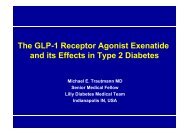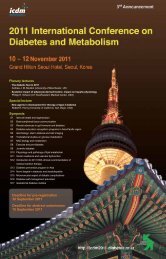Microsoft PowerPoint - src.ppt [\310\243\310\257 \270\360\265\345]
Microsoft PowerPoint - src.ppt [\310\243\310\257 \270\360\265\345]
Microsoft PowerPoint - src.ppt [\310\243\310\257 \270\360\265\345]
Create successful ePaper yourself
Turn your PDF publications into a flip-book with our unique Google optimized e-Paper software.
β cell and Hyperglycemia in Type 2Diabetes : Glucotoxicity and LipotoxicityKyuChang WonDepartment of Internal MedicineYeungnam University College of MedicineDaegu, Korea
Glucotoxicity, Lipotoxicity,Glucolipotocicity• Adverse or toxic influence on pancreatic β cellfunction caused by excessive glucose and/orlipids• Glucotoxicity (1985, Unger RH et al, Diabetologia)• Lipotoxicity (1995, Unger RH, Diabetes)• Glucolipotoxicity (2002, Prentki M et al, Diabetes)- lipotoxicity is dependent on glucose levels
Schema of five stages of progression of diabetes(Weir GC et al Diabetes 53:S17, 2004)
Contribution of glucotoxicity and glucolipotoxicity to the developmentof type 2 diabetes
GlucotoxicityChronic exposure to high glucose in β-cell lines:Insulin mRNAInsulin promoter activityInsulin gene transcription factors(STF-1/PDX-1/IPF-1/IDX-1, MafA, RIPE3b1 activator)Glucose-stimulated insulin secretionInsulin contentChronic exposure to low glucoseAll preserved(RP Robertson et al J Clin Invest 97:1041-1046, 1996)
Biochemical pathways through which elevated glucose can formExcessive levels of reactive oxygen species (ROS)
The glucotoxic effect on insulin gene expression via loss of PDX-1 and MafA(RP Robertson J Biol Chem. 2004 Jul 16 )
Time-dependent disappearance of MafA binding relative tothe disappearance of PDX-1 binding to islet DNA duringcontinuous culturing and weekly passaging of HIT-T 15 cells% DNA binding70 80 90 100 110 120 130Passage week (Harmon JS et al, Diabetes 1998)
1.5†‡Insulin/ b-actin mRNA1.00.5*00 10 20 50 50+NACHydrogen Peroxide (mM)Effect of H 2 O 2 on insulin gene expression
The effects of high glucose on the intracellular peroxide level and GSIS in the INS-1 cells and rat islets(Won KC et al. J Korean Med Sci 21:418-24, 2006)
Chronic exposure to high glucose concentration induces glucotoxicity(Park KG et al. Diabetes 56:431-37, 2007)
Clinical correlations between glucotoxicityand oxidative stress of the β cell
γ GCS m RNAGSH level (µmol/mg)4443424140393837363534*5.6 mM glucose 30 mM glucose* p
GSH level (mmol/mg)0.380.370.360.350.340.330.320.31* p
mesothelial cellsleukocytesGSH level (µmol/mg)10 *9876543210Controls Diabetics* p
* p
γ -GCS Expression : Summary & Conclusion• Decreased GSH level, γ -GCS expression, GSIS and increased peroxide level inINS-1 cells exposed to high glucose• Decreased GSH level, γ -GCS expression and increased Ox-LDL, MDA level atleukocytes and mesothelial cells from patients with T2DMesp, poorly controlled patients• Insufficient antioxidant defense by the GSH pathwaymay be one of the factors responsible for developmentof complications in patients with type 2 diabetes
Lipotoxicity• Acquired cause of impaired β-cell function• Short term exposure of islets to FFA- stimulates insulin secretion- LCFA Fatty acyl CoA DAG PKC Exocytosis• Long term exposure of islets to FFA- inhibit insulin secretion- through Randle cycle(McGarry JD Diabetes 51: 7-18, 2002)
Effects of glucose on lipid partitioning in the β cell
Prolonged exposure to increased FFA concentration induces beta-cell death(Lupi R et al. Diabetes 51:1437-42, 2002)
(McGarry JD Diabetes 51: 7-18, 2002)
Antioxidant strategies to protectthe β cells from hyperglycemia
Oxidative stressAdaptiveresponseEPO generepressionActivation of antioxidantdefensesRepression of ROSproducingsystemsTF activation(e.g. AP-1, NF-χB, Nrf2)Immediate-early geneinduction (e.g. c-fos)TF inhibitionSpecific decrease in(e.g. NFI) RNA stabilityInduction of antioxidant genes:Glutathione peroxidaseCatalaseSODγ-GlutamylcysteinesynthaseGlutathione reductaseThioredoxinThioredoxin reductaseQuinone reductaseMetallothioneinHeme oxygenaseFerritin ...+Activation of several other genes (e.g. cytokines)CYP1A1repressionMitochondrialactivityshutdown+TransferrinreceptordecreaseNADPHoxidaseinhibition(Y Morel et al Biochem J 342:481-496,1999)
Metformin↓ ACC activityPhosphorylation/activation of AMPK↓ SREBP-1 expression↓ SREBP-1 activity↓ Hepatic gene expression : FAS,L-PK,S14↑ Muscle glucose transport?↓ Hepatic FA, VLDL synthesis(↑hepatic FA oxidation)↓ Hepatic glucose production↓ Hapatic steatosis↑ Liver insulin sensitivity↓ Plasma glucose, triglyceride, FFAModel for the mechanism by which metformin mediates effects on lipid and glucose metabolism
Control MetforminLeptin (ug) 0 0.1 1 0 0.1 1pAMPKAMPKpSTAT3STAT3pAMPK/AMPK, arbitary units6543210* **0 0.6 15 0 0.6 15pSTAT3/STAT3963** **,††**Leptin (ug/D)Leptin (ug/D)UntreatedTreated0vehicleleptin(0.1ug)leptin(1ug)vehicleleptin(0.1ug)leptin(1ug)UntreatedTreatedpAMPK levels in the hypothalamus by metformin treatment(Kim YW et al. Diabetes 55:716-724, 2006)
• Metformin restores insulin secretion altered by chronicexposure to free fatty acid or high glucose(Patane G et al. Diabetes 49:753-740,2000)• Activation of the AMP-activated protein kinase by the antidiabeticdrug metformin in vivo(Zou MH et al. J Biol Chem 279:43940-43951,2004)•Metformin, but not leptin, regulated AMP-activated proteinkinase in pancreatic islets: impact on GSIS(Leclerec I et al. Am J Physiol Endocrinol 286:1023-1032,2004)
Lipotoxicity in Human Pancreatic Islets and the Protective Effect ofMetformin(Diabetes 51 (Suppl. 1):S134–S137, 2002)
ControlFFAMetforminFFA+MetforminIslet perifusion experiments showing the dynamics of insulin secretion(Diabetes 51 (Suppl. 1):S134–S137, 2002)
Metformin in β cells• To evaluateWhether1) glucose, metformin regulates AMPK in INS-1 cell2) changes in AMPK modulate insulin secretion3) metformin prevents glucose toxicity
Fluorescence Intensity654321Intracellular Peroxide Level*p-AMPKβ-actin05.6 mM G 30 mM G5.6 30 mM glucose12001000GSIS4 mM G16.7 mM G65AMPK activity800600400*432*200105.6 mM G 30 mM G05.6 mM G 30 mM G* p
100Metformin 25 µg/mlFluorescence Intensity908070605010090805.6 mM G 5.6 mM (+) 30 mM G 30 mM (+)Metformin 2.5 µg/ml****7060505.6 mM G 5.6 mM (+) 30 mM G 30 mM (+)* p
INS-1 Cell704 mM G6016.7 mM G5040*(30 mM Glucose)p-AMPK30β-actin200 25 µg/ml metformin1005.6 mM G 30 mM Gmetformin (-) (+) (-) (+)*p
Metformin : Summary & Conclusion• High glucose increases oxidative stress and decreases GSIS in INS-1 cell• Glucose decreases AMPK phosphorylation in INS-1 cell• Metformin stimulates AMPK and regulates oxidative stress and insulinsecretion in INS-1 cellAt 30 mM glucose : metformin increases GSIS• Metformin may protect glucose toxicity & lipotoxicity• Activation of AMPK by metformin might contribute to thebeneficial effects of metformin in treating diabetes
GLP-1 Preserved Morphologyof Human Islet Cells In VitroControlGLP-1–treated cellsDay 1Day 3Islets treated with GLP-1 inculture were able to maintaintheir integrity fora longer period of timeDay 5Adapted from Farilla L et al Endocrinology 2003;144:5149–5158.
Des-fluoro-sitagliptin (DFS):11-Week Treatment in HFD/STZ Diabetic MiceNon-diabetic Diabetic +vehicleDiabetic + DFS0.1%Diabetic + DFS0.4%Diabetic + DFS1.1%(green=β, red=α)Mu et al. Diabetes 55:1695–1704, 2006
• Antioxidant enzymes :Superoxide dismutase, Catalase, Glutathione Peroxidase• Heat Shock Proteins :HSP 70Heme Oxygenase-1
• Complementary action of antioxidant enzymes in the protection ofbioengineered insulin-producing RINm5F cells against the toxicity ofreactive oxygen species. (Tiedge M et al Diabetes 47:1578-1585, 1998)• Protection against the co-operative toxicity of nitric oxide and oxygenfree radicals by overexpression of antioxidant enzymes inbioengineered insulin-producing RINm5F cells.(Tiedge M et al Diabetologia 42:849-855, 1999)• Stable expression of manganese superoxide dismutase in insulinomacells prevents IL-1beta-induced cytotoxicity and reduces nitric oxideproduction. (Hohmeier HE et al J Clin Invest 101:1811-1820, 1998)• Contribution of adenoviral-mediated superoxide dismutase genetransfer to the reduction in nitric oxide-induced cytotoxicity on humanislets and INS-1 insulin-secreting cells.(Moriscot C et al Diabetologia 43:625-631, 2000)
β- cellIL-1βIL-1β receptorAminoguanidinem RNAProtein synthesisiNOSHsp 70ProtectionNODestructionMitochondria:phosphorylationInsulin
(A)122 Kd80 Kd(B)51 KdDensity (% Control)3 0 02 5 02 0 01 5 01 0 0*P
Heme degradation pathwayHemeHeme OxygenaseFe 3+ , CO*BiliverdinBiliverdin ReductaseBilirubin** Antioxidant action• Carbon monoxide protects pancreatic beta-cells from apoptosis and improvesislet function/survival after transplantation(Gunther L et al. Diabetes 51: 994-999, 2002)
Protective effect of Heme Oxygenase-1 in INS-1 cellFluorescence Intensity654321Intracellular Peroxide Level*654321HO-1 expression*05.6 mM G 30 mM G05.6 mM G 30 mM G12001000GSIS4 mM G16.7 mM G65HO-1 activity*800600400*432200105.6 mM G 30 mM G05.6 mM G 30 mM G*p
1000 4 mM G16.7 mM G800INS-1 Cell*p
HO-1 mRNAβ-actin mRNAAfter HO-1 ad infection900 4 mM G80016.7 mM G70060050040030020010005.6 mM G 30 mM G HO-1 30mM GGSIS after 3 days subculture (2hrs exposure of HO-1 adenovirus) : INS-1 cell
HO-1 : Summary & Conclusion• Heme Oxygenase-1 seems to mediate protectiveresponses of pancreatic islets against oxidativestress due to hyperglycemia
Lipotoxicity and Type 2 Diabetes
Relative risk for T2DM by BMI in women aged 30-55 years(Colditz GA et al. Ann Intern Med 122:481-486, 1995)
FFAs in the pathogenesisof type 2 diabetes(Wilding JPH Diabet Med 24:934-945, 2007)
Randomized, controlled Type 2 DM prevention studies
Glucotoxicity vs. LipotoxicityGlucolipotoxicity
Most individuals with increased circulating lipid levelshave normal β-cell functionLipotoxicity only occurs in the context of chronic hyperglycemia(RP Robertson et al. Diabetes 53(S1): S119-S124, 2004)(Kelpe BI et al. Diabetes 51: 662-668, 2002)Long term exposure of islets to FFA : inhibit insulin secretion(McGarry JD Diabetes 51: 7-18, 2002)
Consequences of treating ZDF rats with the lipid-lowering drug bezafibrate or theglucose-lowering agent phorizin agent for 6 weeks beginning at 6 weeks of age(Harmon JS et al. Diabetes 50:2481-2486, 2001)
Fatty acid translocase cluster determinant 36 (FAT/CD36)and glucolipotoxicity in INS-1 cells
IntestinalLumenLipaseACAT: Acyl Co-A:Cholesterol AcylTransferase; DGAT: DiacylGlycerol AcylTransferase; MTP: Microsomal Triglyceride Transfer Protein
High glucose levels increase cholesterol absorption• The study proposes that glucose-mediated intestinal cholesterol may contribute toincreasing circulating cholesterol and, consequently, the risk of developing CHD, afeature of T2DM.Ravid Z. Am J Physiol Gastrointest Liver Physiol. 2008 Sep 4.
High glucose levels increase cholesterol absorption• Effect of glucose concentrations on the protein expression of transporters mediatingcholesterol influx. Caco 2/15 cells were cultured for 24 h in DMEM containing 5 or 25 mMglucose.• Western blot was used to analyze the protein expression of NPC1L1 (A), CD36 (B)NPC1L1β-actinCD36β-actinA1.0Relative protein expression0.80.60.40.20.0*5mM 25mMB0.6Relative protein expression0.50.40.30.20.10.0Ravid Z. Am J Physiol Gastrointest Liver Physiol. 2008 Sep 4.*5mM 25mMThe higher glucose levels, the higher proteinexpression of NPC1L1 and CD36, which result inhigher cholesterol uptake
• To determine whether prolonged exposure ofpancreatic islets to a glucolipotoxic conditiondisrupts CD36 or increases CD36• To evaluate a role of CD36 in pancreatic isletsagainst glucolipotoxicity
FAT/CD36*ㅜㅜ ㅜ* p
Insulin mRNAㅜㅜㅜ% of controlㅜㅜㅜ ㅜㅜ * * p
• At only lipotoxic condition (5.6 mM glucose and 0.5 mMpalmitate), PDX-1 and insulin mRNA in INS-1 cells were notdecreased compared to 5.6 mM glucose media.• The insulin mRNA levels, PDX-1 and GSIS were decreased inINS-1 cells exposed to glucolipotoxic condition (30 mM glucoseand 0.5 mM palmitate) compared to 5.6 mM glucose media .• At INS-1 cells exposed to glucolipotoxic condition (30 mMglucose and 0.5 mM palmitate), CD 36 was significant increasedcompared to normal glucose media.
•These results suggest that the influx offatty acid to islet at high glucosecondition can be increased byincreasing of CD36•At islets exposed to high glucose, highfatty acid may be exacerbating β celldysfunction via increasing of CD 36
Summary
• There are ample evidences at the cellular level1) Glucotoxicity & oxidative stress : Glucose form ROS2) Pancreatic islets contain an usually low complement of antioxidantproteins and activity but normal γ -GCS expression3) Antioxidant drugs improve pancreatic islet survival in the face ofoxidative stress4) Gene transfer techniques can be used to overexpress antioxidantenzymes or HO-1 which provide enhanced protection of pancreaticbeta cells against oxidative stress5) At islets exposed to high glucose, high fatty acid may beexacerbating β cell dysfunction via increasing of CD 366) Because hyperglycemia is a prerequisite for lipotoxicity to occure,the term glucolipotoxicity, rather than lipotoxicity, is moreappropriate
• In human studies of type 2 diabetes1) Markers of oxidative stress are increased in type 2 diabetics2) Reducing plasma FFA levels may decrease the relative riskfor type 2 diabetes3) Glucolipotoxicity are secondary phenomena that areproposed to play a role in all forms of type 2 diabetes4) What new strategies might be utilized to protectthe β cell against glucolipotoxicity in type 2 diabetes ?: NAC ? GLP-1 ? DPP IV inhibitors ? etc…..
Acknowledgement• Yeungnam University College of Medicine, Internal MedicineHyoung Woo LeeJi Sung Yoon• Pacific Northwest Research InstituteR Paul RobertsonJamie S HarmonPhuong Oanh T Stephan• Yeungnam University College of Medicine, PhysiologyYong Woon KimJong Yeon KimSo Young parkJung Yoon Huh• Kyuungbook National University, Internal MedicineIn Kyu Lee• Keimyung University, Internal MedicineKeun Gyu Park• Tanaka Yoshito
감사합니다


![Microsoft PowerPoint - src.ppt [\310\243\310\257 \270\360\265\345]](https://img.yumpu.com/47977670/1/500x640/microsoft-powerpoint-srcppt-310243310257-270360265345.jpg)

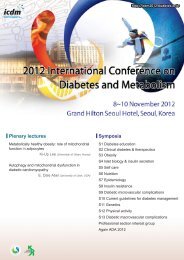
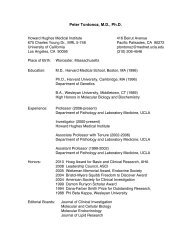
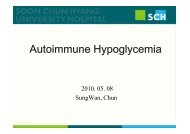



![Microsoft PowerPoint - src.ppt [\310\243\310\257 \270\360\265\345]](https://img.yumpu.com/44373305/1/190x134/microsoft-powerpoint-srcppt-310243310257-270360265345.jpg?quality=85)
